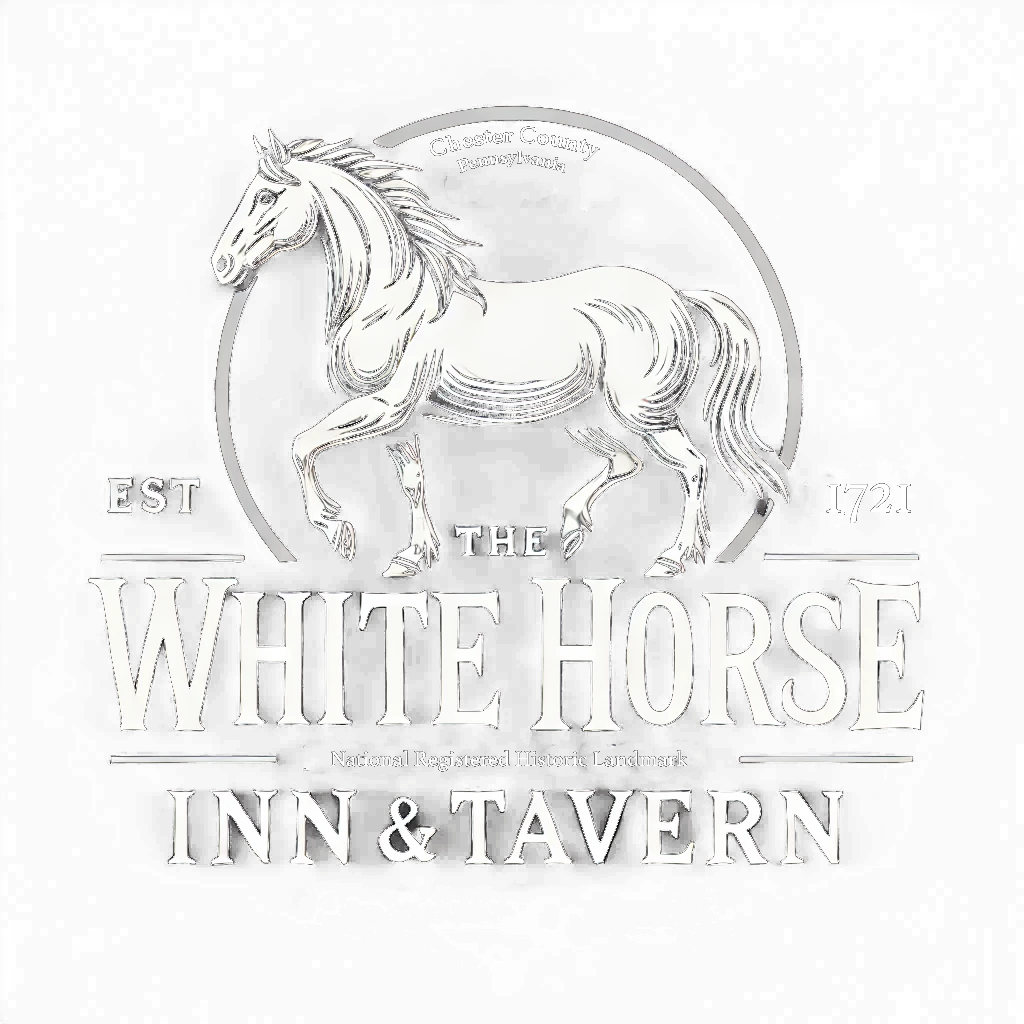The history of the White Horse Tavern starts with James Thomas.
He was originally from Marion, Pa:
James Thomas of Merion. From Llandboyden, Caermarthenshire. Will proved in Philadelphia, August 10, 1699. He mentions his sons Nathan Thomas and James Thomas, Jr. Mentions wife Margaret sons Thomas and Owen Daughters Elizabeth and Catharien grandchildren, Nathan and Ann. Brother-in-law, David Jones; brother-in-law, Thomas Howell. Legacies to Meeting Houses, Merion, Haverford and Radnor. Mentions Duffryn Mawr. Executors, wife Margaret, son Nathan. Witnesses, Lewis David and Rowland Ellis. [Mention in will Contradicts Twaddell’s reference to “Duffryn Mawr” in 1706]
James Thomas, Jr. and Owen Thomas, sons of James Thomas of Merion, settled in Whiteland, Chester Co. Pa. They became Baptists, members of Great Valley Baptist Church. Owen was a Preacher.
4, 1, 1695. James Thomas of Merion, yeoman and Ann Warner of Schoolkillbrook, in said Co. of Philadelphia, spinster, at Meeting House of Schoolkillbrook. Wit: James, Nathan and Owen Thomas; John, Isaac and Isaac Warner.
The name of James Thomas is on the List of Taxables 1693. James Thomas, Sen. And James Thomas, Jun. 1696.
Grace Thomas, widow, Phila. Will proved June 1, 1695. Mentions brother-in-law, James Thomas. Sons Mycah, Gabriel, James, the last executor. Daughters, Elizabeth Thomas, Mary Snead, Rachel Warton, 2 other children not named. Mentions Jane, wife of Evan Oliver; Morgan Jones, Mary Hilliard. Signed 7, 25, 1694-5. Wit: Henry Clifton, Robt. Burrow, Mary Hilliard.
Gabriel Thomad, Phila. Yeoman. Will proved Dec. 22, 1714. Mentions Elizabeth, eldest, and Grace, youngest daughters of sister Mary Snead. Wit. John Cadwallader, Phila. Gent., John Warden, Phila. Hatter.
Wm. Snead, Mary Thomas, married 10, 28, 1688. Marriage recorded at Philadelphia Friends’ Meeting.
— The Incompleted Burial Records of Merion (PA) Meeting Grave-yard by Margaret B. Harvey, A.M.
James Thomas built the original White Horse Tavern sometime around 1711, possibly earlier given his purchase of the land in 1706, selling his earlier ownership in what was most of Ardmore to his in-laws.
On the afternoon of August 10, 1706, James Thomas stood amidst the property he had just acquired and, drinking in the fine view it offered, decided to call it “Duffryn Mawr,” translating from the old Welsh as “Great Valley.”
— Inns Tales and Taverns of Chester County by Meg Daly Twaddell, 1984, page 36
He was a constable of the Whiteland township:
According to the township book, the following persons held the office of constable prior to 1726, beginning with 1710: Isaac Malin, James Thomas, Edward Kinneson, Lewis Williams, David Meredith, Sr., Evan Lewis, Eees Pritchard, Thomas Owen, James Rowland, James David, Richard Anderson, Isaac Richardson, Thomas James, John Spruce, Owen Thomas, Evan Philips. The first supervisor was James Thomas, in 1714, and Griffith Howell is mentioned in 1724. George Aston and John Spruce were the first overseers of the poor, appointed in 1730.
— Futhey, John Smith. History of Chester County, Pennsylvania, with genealogical and biographical sketches (Kindle Locations 15711-15715). Philadelphia, L. H. Everts. Kindle Edition.
In 1715 he was taxed twice as much as anyone else in the township.
Charles Browning in Welsh Settlements in Pennsylvania references James Thomas receiving 250 acres in 1686. Is this Thomas’s first land in Whiteland inherited from his father (also James)?
By the usual deeds of lease and release, dated 24. and 25. Oct. 1681, William Penn conveyed to William Jenkin, or Jenkins, “a Friend who had suffered,” of Tenby, in Pembroke, 1,000 acres of land. Of this grant, Jenkins conveyed 600 acres to Francis Howell, of Llancilio, in Caermar then, by deed of 1 Sept. 1686, which tract was laid out to him in Duffryn Mawr, or Whiteland tp., in Chester Co. The balance of the grant was also located in Duffryn Mawr and laid out to Jenkins, who conveyed 250 acres of it, by deed of 30 Sep.1686, to James Thomas.
— Browning, Charles J., Welsh settlements in Pennsylvania, 1912, page 200.
In 1701 James (perhaps the son?) has a total of 300 acres in the Welsh Tract.
By deed of 8. 3 mo. 1695, the relict and the overseers conveyed David Morgan’s 100 acres to James Thomas, who willed the same to his second son, Nathan Thomas. In 12 mo. 1701, James Thomas had 100 acres of the Richard Davies patent located in Merion, and altogether, at this time, he held 300 acres in the Welsh Tract.
— Browning, Charles J., Welsh settlements in Pennsylvania, 1912, page 227.
